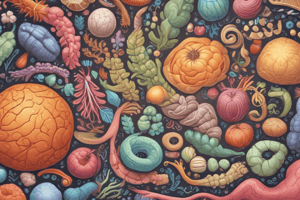Podcast
Questions and Answers
What is the primary structural difference between amylose and amylopectin?
What is the primary structural difference between amylose and amylopectin?
- Amylopectin has branched chains of glucose monomers. (correct)
- Amylopectin is a straight-chain polymer.
- Amylose has shorter chains of glucose monomers.
- Amylose contains more glucose units than amylopectin.
Which polysaccharide is primarily composed of α-d-glucose?
Which polysaccharide is primarily composed of α-d-glucose?
- Amylose (correct)
- Cellulose
- Sucrose
- Chitin
Why is sucrose soluble in water on a chemical level?
Why is sucrose soluble in water on a chemical level?
- It has a nonpolar structure.
- It contains multiple hydroxyl groups that can interact with water. (correct)
- It forms insoluble complexes with water.
- It is a crystalline solid that repels water.
What is the proportion of amylose and amylopectin in natural starches?
What is the proportion of amylose and amylopectin in natural starches?
What happens to amylose when tested with iodine solution?
What happens to amylose when tested with iodine solution?
How are the glucose monomers in polysaccharides joined together?
How are the glucose monomers in polysaccharides joined together?
What structural feature distinguishes branched polysaccharides like amylopectin from linear ones like amylose?
What structural feature distinguishes branched polysaccharides like amylopectin from linear ones like amylose?
Which one of the following is NOT a characteristic of amylopectin?
Which one of the following is NOT a characteristic of amylopectin?
What is the basic building block of carbohydrates?
What is the basic building block of carbohydrates?
Which of the following describes a disaccharide?
Which of the following describes a disaccharide?
What type of reaction forms glycosidic linkages in carbohydrates?
What type of reaction forms glycosidic linkages in carbohydrates?
Which polysaccharide is primarily used for energy storage in plants?
Which polysaccharide is primarily used for energy storage in plants?
What characteristic of monosaccharides contributes to their water solubility?
What characteristic of monosaccharides contributes to their water solubility?
What is an example of a disaccharide?
What is an example of a disaccharide?
What type of bond joins monosaccharide units in polysaccharides?
What type of bond joins monosaccharide units in polysaccharides?
Which property distinguishes cellulose from starch?
Which property distinguishes cellulose from starch?
What is the molecular formula of glucose?
What is the molecular formula of glucose?
Which of the following describes the solubility of carbohydrates in water?
Which of the following describes the solubility of carbohydrates in water?
What type of polymerization reaction leads to the formation of polysaccharides?
What type of polymerization reaction leads to the formation of polysaccharides?
In terms of structure, how do polysaccharides like cellulose and starch compare to synthetic polymers?
In terms of structure, how do polysaccharides like cellulose and starch compare to synthetic polymers?
What distinguishes proteins from synthetic polymers?
What distinguishes proteins from synthetic polymers?
What is the common characteristic of biopolymers such as polysaccharides?
What is the common characteristic of biopolymers such as polysaccharides?
Which of the following statements about biopolymers is incorrect?
Which of the following statements about biopolymers is incorrect?
What is a key feature of the structure of proteins as specified in the discussion of biopolymers?
What is a key feature of the structure of proteins as specified in the discussion of biopolymers?
Flashcards are hidden until you start studying
Study Notes
Polysaccharides
- Polysaccharides are large polymers made up of many monosaccharide monomers linked together by glycosidic linkages.
- Starches and cellulose are abundant natural polysaccharides.
- Both starches and cellulose are composed of D-glucose monomers.
- These polymers can contain up to 5000 glucose units.
- Plant starch is stored in protein-covered granules until glucose is needed for synthesis or energy.
- Granules rupture at high temperatures, yielding two starches: amylose and amylopectin.
- Natural starches contain about 75% amylopectin and 25% amylose.
- Amylose is a straight-chain polymer with an average of 200 glucose monomers per molecule.
- Amylopectin is a branched-chain polymer with about 1000 glucose monomers arranged in branched chains.
Carbohydrates
- Monosaccharides are simple sugars containing one saccharide molecule.
- Disaccharides are composed of two monosaccharide units joined together, such as sucrose (glucose and fructose) or maltose (two glucose units).
- Polysaccharides are polymers containing many monosaccharide units, up to several thousand.
Glycosidic Linkage
- Monomer units in disaccharides and polysaccharides are joined by a glycosidic linkage between carbons 1 and 4 or 1 and 6 of adjacent monosaccharide units.
- Glycosidic linkages are formed by a condensation reaction, similar to those in synthetic polymer formation.
- A water molecule is released during the formation of each glycosidic bond.
Studying That Suits You
Use AI to generate personalized quizzes and flashcards to suit your learning preferences.




